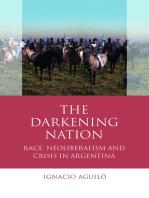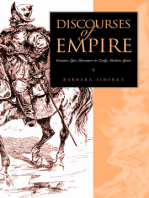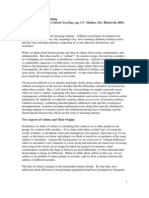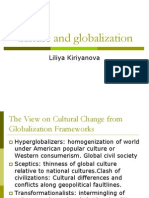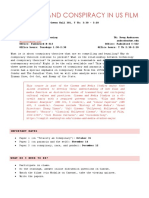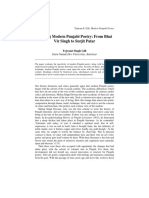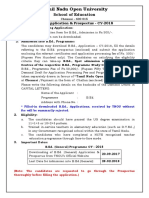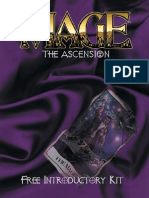Appadurai Breckenridge - Why Public Culture
Appadurai Breckenridge - Why Public Culture
Uploaded by
SakhiUpadhyayaCopyright:
Available Formats
Appadurai Breckenridge - Why Public Culture
Appadurai Breckenridge - Why Public Culture
Uploaded by
SakhiUpadhyayaOriginal Description:
Copyright
Available Formats
Share this document
Did you find this document useful?
Is this content inappropriate?
Copyright:
Available Formats
Appadurai Breckenridge - Why Public Culture
Appadurai Breckenridge - Why Public Culture
Uploaded by
SakhiUpadhyayaCopyright:
Available Formats
DEBATES AND CONTROVERSIES
Why Public Culture?
Arjun Appadurai
Carol A. Breckenridge
The world of the late twentieth century is increasingly a cosmopolitan
world. More people are widely travelled, are catholic in their tastes, are
more inclusive in the range of cuisines they consume, are attentive to worldwide news, are exposed to global media-covered events, and are influenced
by universal trends in fashion.
In recent decades, India has developed forms of public culture which
draw it into the cosmopolitanism of the rest of the world. Yet today's cosmopolitan cultural forms contain a paradox. As forms, they are emerging
everywhere: films, packaged tours, specialized restaurants, video-cassettes
and sports spectacles seem to be drawing the world into a disturbing commercial sameness. But as vehicles for cultural significance and the creation
of group identities, every society appears to bring to these forms its own
special history and traditions, its own cultural stamp, its own quirks and
idiosyncracies.
A study of cosmopolitan cultural forms such as domestic tourism in
contemporary India would be of considerable and intrinsic interest for those
concerned to understand modernity as a global phenomenon. However, we
would like to propose that these cosmopolitan forms raise a larger set of
terminological as well as interpretive problems about the way in which public life in the contemporary world is being culturally articulated. This larger
problem can fruitfully be engaged by hypothesizing an arena - which we
call public culture - in which the emergent cosmopolitan cultural forms of
today's India shape each other.
Though we have used the term public culture as a label which unites the
above cosmopolitan cultural forms, we do not regard the term as one whose
meaning and utility are self-evident. Our grasp of this emergent domain is
tentative, our understanding of its unity is hypothetical, and our spirit in interpreting it as a coherent cultural domain is exploratory. Thus, the term
Public Culture Bulletin
Vol. 1, No. 1: Fall 1988
Public Culture Bulletin
public culture, and the structure which underlies the phenomena to which it
points, are also for us matters for inquiry. It is this aspect of our concern
with the implications of a little-used label and a p r l y charted contemporary
cultural domain which underlies the terminological and disciplinary discussion which follows.
Why use the adjective public for cultural forms that appear to be well
described by so many other, more familiar ones like popular, mass, folk,
consumer, national, or middle class? The term public is not a neutral or arbitrary substitute for all these existing alternatives. Nevertheless, it appears
to be less embedded in such highly specific Western dichotomies and debates as high versus low culture; mass versus elite culture; and popular or
folk versus classical culture. With the term public culture we wish to escape
these by now conventional hierarchies and generate an approach which is
open to the cultural nuances of cosmopolitanism and of the modem in India.
This leads to the second reason for the use of the term public. The term
public culture is more than a rubric for collectively thinking about aspects of
modem life now thought about separately. It also allows us to hypothesize
not a type of cultural phenomenon but a zune of cultural debate. We now
speculate that this zone may be characterized as an arena where other types,
forms and domains of culture are encountering, interrogating and contesting
each other in new and unexpected ways. Thus national culture seeks to
coopt and redefine more local, regional or folk cultural forms as witnessed
in the Festivals of India, and their recent analogue celebrated in Delhi as
'our festival' (apna utsav). Commercial culture (especially in the cinema,
television and audio industries) seeks to popularize classical forms as can be
seen in the growing popularity of the ghazal, an Islamic musical form performed in public. Mass cultural forms seek to coopt folk idioms as in the
use of religious and historical motifs in the Hindi cinema.
Since the end of World War 11, and the independence of many nonWestern countries from colonial rule, another powerful agency for the production and definition of culture throughout the world has been the nationstate. National cultures are now intentional elite products which draw on
elite, folk, mass and popular forms, and use indigenous as well as cosmopolitan technologies of reproduction and dissemination.
Yet, public culture is not the same as national culture, for national culture is itself a contested mode, embattled, on the one hand, by transnational
cultural messages and forces (which sometimes threaten the nation-state),
and, on the other hand, by indigenous critiques from the various sectors that
continuously threaten the cultural hegemony of the nation-state. Most of all,
Why Public Culture?
national culture in countries like India is the site of an uneasy collaboration
between the cultural agencies of the nation-state and the private, largely
commercial agencies which dominate certain kinds of cultural production.
Today, in India, the control of cultural production is shared in a fragile and
variabIe way between the state and private enterprise,depending on the kind
of cultural product that is involved.
Public culture in late twentieth century India is thus a contested terrain.
The actors in the contest are a variety of producers of culture and their audiences; the materials in the contest are the many cultural modalities we have
discussed; and the methods, increasingly shared by all parties, involve the
mass media, as well as mechanical modes of reproduction. What is at stake
in the contest is, of course, no less than the consciousness of the emergent
Indian public. The messages of public culture are therefore directed to audiences without regard to the limits of family, locality or social category.
This does not mean that the new images are directed to a homogeneous and
universal Indian, but that they are designed to appeal to a diversity of audiences. Their rhetoric is ecumenical, not parochial, and under the present
political regime they are intended to create the new citizen.
Public culture allows us not only to hypothesize a terrain of contest and
debate in contemporary India, but also directs our attention to some limitations in current approaches to culture among anthropologists and historians.
Since it involves trans-local and self-conscious forms of cultural production
(and consumption), the analysis of public culture through its cosmopolitan
cultural forms entails a revisionist approach to traditional anthropological
concepts of culture, which were designed for small-scale,well-bounded and
stable societies. The world which cultural anthropologistshave so far taken
for granted is in the process of vanishing. More and more societies are
characterized by profound internal cultural debates (Parkin 1978); are encompassed by parts of the larger world-system; are exporting their members
(as migrants) to other societies; and are involved in deliberately constructing
not just their national or ethnic identities, but their traditions and cultures
themselves (Hobsbawn and Ranger 1983).
This cul ture-making activity includes the conscious writing of national
histories, the construction of national and folk symbols and rituals, and the
revitalization of various traditional identities. Once regarded as deviant,
quaint or quirky features of certain societies (sometimes labelled modernizing, new, or third world nations), such activities can now be seen as a fundamental ideological process in all nation-states. The interaction between the
central elites of these societies - the artists, bureaucrats, ideologues, media
Public Culture Bulletin
experts - who are central to this culture-making, and the smaller communities within these nation-states, is characterized by debate, efforts at cultural
hegemony, and movements to resist such hegemony, all of which come
both from the state and from private sources. These processes occur
increasingly in interactional contexts formed by media, market and travel
dynamics, in which leapfrogging of technological or social stages, as well
as bypassing of social or political levels in intergroup communication, are
becoming commonplace.
Likewise, the idea of public culture challenges and expands the historian's notions of culture, which have tended to be predicated on such
hierarchies and polarities as high and low, and elite and popular culture. The
idea of public culture - that is culture which reflects the more or less
unmediated or pristine practices of a community - has in recent years become largely the province of social historians, especially those working on
pre-modern Europe (e.g., Burke 1976). Increasingly, however, those
working in other parts of the world, including Africa, China, Japan, India
and Latin America, and those working in other disciplines including literature, anthropology and political science, have turned their attention to popular culture.
Popular culture, in contemporary usage, refers to the ideas and practices
of the inarticulate and converges with the reaction, which characterized the
1960's and early 1970's, among social historians of Europe, against the
sources, voices and prejudices of elite history, of history from above. Peter
Burke's conception of popular culture, for example, involves the study of
"attitudes and values of shopkeepers and factory workers, servants and
fishermen, peasants and craftsmen, beggars and thieves, and their embodiment in such diverse, but at least partially symbolic, activities as
witchcraft, pilgrimages and carnivals" (ibid.: 69). This captures the program
of much work done in Europe since the early 1960s, and in many other
areas today.
Part of our long-term concern is to persuade both historians and anthropologists that current notions of popular, folk or traditional cultural forms
simply are not adequate for the interpretive challenges posed by the
cosmopolitan forms of today's public cultures. Where popular culture is
often the product of urban, commercial and state interests, where folk culture is often a response to the competitivecultural policies of today's nationstates, and where traditional culture is often the result of conscious
deliberation or elaboration, these terms clearly need rethinking. We intend
Why Public Culture?
that our argument in favor of the rubric public culture should provide a
fruitful vantage-point for such consideration.
Bibliography:
Burke, Peter, Popular Culture in Early Modern Europe. New York: New York University Press, 1978.
Hobsawm, Eric and Terence Ranger (eds.), The Invention of Tradition. New York
Columbia University Press, 1983.
Parkin, D., The Cultural Definition of Political Response. London: Academic Press,
1978.
Extract from:
Introduction to
Public Culture in Late TwentiethCertrury India
edited collection of essays (forthcoming).
You might also like
- High Religion: A Cultural and Political History of Sherpa BuddhismFrom EverandHigh Religion: A Cultural and Political History of Sherpa BuddhismNo ratings yet
- The clamour of nationalism: Race and nation in twenty-first-century BritainFrom EverandThe clamour of nationalism: Race and nation in twenty-first-century BritainNo ratings yet
- The Participant: A Century of Participation in Four StoriesFrom EverandThe Participant: A Century of Participation in Four StoriesRating: 5 out of 5 stars5/5 (1)
- The Darkening Nation: Race, Neoliberalism and Crisis in ArgentinaFrom EverandThe Darkening Nation: Race, Neoliberalism and Crisis in ArgentinaNo ratings yet
- Moment to Monument: The Making and Unmaking of Cultural SignificanceFrom EverandMoment to Monument: The Making and Unmaking of Cultural SignificanceLadina Bezzola LambertNo ratings yet
- The Scattered Court: Hindustani Music in Colonial BengalFrom EverandThe Scattered Court: Hindustani Music in Colonial BengalNo ratings yet
- Vision, Race, and Modernity: A Visual Economy of the Andean Image WorldFrom EverandVision, Race, and Modernity: A Visual Economy of the Andean Image WorldRating: 2 out of 5 stars2/5 (1)
- Shaping Urban Futures in Mongolia: Ulaanbaatar, Dynamic Ownership and Economic FluxFrom EverandShaping Urban Futures in Mongolia: Ulaanbaatar, Dynamic Ownership and Economic FluxNo ratings yet
- Sense and Essence: Heritage and the Cultural Production of the RealFrom EverandSense and Essence: Heritage and the Cultural Production of the RealNo ratings yet
- The Anthropology of Sport and Human Movement: A Biocultural PerspectiveFrom EverandThe Anthropology of Sport and Human Movement: A Biocultural PerspectiveRobert R. SandsNo ratings yet
- Global Borderlands: Fantasy, Violence, and Empire in Subic Bay, PhilippinesFrom EverandGlobal Borderlands: Fantasy, Violence, and Empire in Subic Bay, PhilippinesNo ratings yet
- Up, Down, and Sideways: Anthropologists Trace the Pathways of PowerFrom EverandUp, Down, and Sideways: Anthropologists Trace the Pathways of PowerNo ratings yet
- Culture and RhetoricFrom EverandCulture and RhetoricIvo StreckerNo ratings yet
- Navigating Austerity: Currents of Debt along a South Asian RiverFrom EverandNavigating Austerity: Currents of Debt along a South Asian RiverNo ratings yet
- Bengal in Global Concept History: Culturalism in the Age of CapitalFrom EverandBengal in Global Concept History: Culturalism in the Age of CapitalRating: 3 out of 5 stars3/5 (2)
- Toxic Exposures: Contested Illnesses and the Environmental Health MovementFrom EverandToxic Exposures: Contested Illnesses and the Environmental Health MovementRating: 2 out of 5 stars2/5 (1)
- Discourses of Empire: Counter-Epic Literature in Early Modern SpainFrom EverandDiscourses of Empire: Counter-Epic Literature in Early Modern SpainNo ratings yet
- Reflections on Cultural Policy: Past, Present and FutureFrom EverandReflections on Cultural Policy: Past, Present and FutureNo ratings yet
- Presence: Philosophy, History, and Cultural Theory for the Twenty-First CenturyFrom EverandPresence: Philosophy, History, and Cultural Theory for the Twenty-First CenturyNo ratings yet
- Making the Green Revolution: Agriculture and Conflict in ColombiaFrom EverandMaking the Green Revolution: Agriculture and Conflict in ColombiaNo ratings yet
- The Pursuit of Ruins: Archaeology, History, and the Making of Modern MexicoFrom EverandThe Pursuit of Ruins: Archaeology, History, and the Making of Modern MexicoNo ratings yet
- Not Quite Shamans: Spirit Worlds and Political Lives in Northern MongoliaFrom EverandNot Quite Shamans: Spirit Worlds and Political Lives in Northern MongoliaNo ratings yet
- Global Matters: The Transnational Turn in Literary StudiesFrom EverandGlobal Matters: The Transnational Turn in Literary StudiesRating: 4 out of 5 stars4/5 (1)
- Decolonial Mourning and the Caring Commons: Migration-Coloniality Necropolitics and Conviviality InfrastructureFrom EverandDecolonial Mourning and the Caring Commons: Migration-Coloniality Necropolitics and Conviviality InfrastructureNo ratings yet
- Notes in Ge 12 ElecDocument39 pagesNotes in Ge 12 ElecRika Iglesia100% (1)
- Gee 106 Chapter 1Document18 pagesGee 106 Chapter 1Juliana Mae FabrigarNo ratings yet
- PopCulture Chapter 1 To 3Document56 pagesPopCulture Chapter 1 To 3Juliana Mae FabrigarNo ratings yet
- What Is Popular Culture? A Discovery Through Contemporary ArtDocument41 pagesWhat Is Popular Culture? A Discovery Through Contemporary ArtleiNo ratings yet
- CultureDocument29 pagesCultureRafaella EscalaNo ratings yet
- SSC 101 - Popular CultureDocument9 pagesSSC 101 - Popular CultureVictory DamiladeNo ratings yet
- CultureDocument29 pagesCultureRafaella EscalaNo ratings yet
- 5.1 - Popular CultureDocument16 pages5.1 - Popular CultureGaurav100% (1)
- Oxford Handbooks Online: Cultural NationalismDocument23 pagesOxford Handbooks Online: Cultural NationalismEdgard FelipeNo ratings yet
- Pop CultureDocument8 pagesPop CultureNorielyn CamaraoNo ratings yet
- I. Introductive Elements of Culture and CivilizationDocument5 pagesI. Introductive Elements of Culture and CivilizationMarina CrivineantuNo ratings yet
- Module 1Document7 pagesModule 1Jewel Hart Arconeda85% (13)
- Popular Culture Nature Scope and DefinitionDocument3 pagesPopular Culture Nature Scope and DefinitionNianjan chatterjeeNo ratings yet
- Condition of Art and Culture For GlobalizationDocument7 pagesCondition of Art and Culture For GlobalizationDelia TadiaqueNo ratings yet
- Spillman, Lyn - Culture As Meaning MakingDocument4 pagesSpillman, Lyn - Culture As Meaning MakingDomengDomeng0% (1)
- Culture and GlobalizationDocument29 pagesCulture and Globalizationarif_ashraf94No ratings yet
- Com e 1Document5 pagesCom e 1psychesparecNo ratings yet
- Intro. of Pop Culture 2023Document5 pagesIntro. of Pop Culture 2023Aizza D. Sotelo100% (1)
- Chapter 1Document20 pagesChapter 1juricpenasbo2023No ratings yet
- Running Head: Globalziation and Culture 1Document7 pagesRunning Head: Globalziation and Culture 1Anonymous N7bawIxbCNo ratings yet
- Pop Culture PDFDocument6 pagesPop Culture PDFDaeng Muhammad Feisal100% (3)
- MODULE 5 - Identities and Pop CultureDocument5 pagesMODULE 5 - Identities and Pop Culturejoy castillo100% (1)
- History and Cultural Identity: The Philippine Case Rolando M. Gripaldo, PH.DDocument6 pagesHistory and Cultural Identity: The Philippine Case Rolando M. Gripaldo, PH.DTorong VNo ratings yet
- Popular Culture: The Future Is The PastDocument28 pagesPopular Culture: The Future Is The PastBurcica CosminNo ratings yet
- Chapter 2 - Understanding Culture and SocietyDocument5 pagesChapter 2 - Understanding Culture and SocietyJamesel VillaruzNo ratings yet
- 3-4 Media Culture and Society NotesDocument34 pages3-4 Media Culture and Society Notessx kNo ratings yet
- Philippine Popular Culture Module 3Document6 pagesPhilippine Popular Culture Module 3monesallenjayNo ratings yet
- Globalized Arts: The Entertainment Economy and Cultural IdentityFrom EverandGlobalized Arts: The Entertainment Economy and Cultural IdentityNo ratings yet
- Force of Eating: Teacher Note Answer KeyDocument6 pagesForce of Eating: Teacher Note Answer KeyfairfurNo ratings yet
- White - The Concept of CultureDocument26 pagesWhite - The Concept of Culturetapecuim100% (1)
- Lesson Plan - MasterDocument3 pagesLesson Plan - MasterMNNo ratings yet
- LN Intro PH FinalDocument17 pagesLN Intro PH FinalxenoyewNo ratings yet
- Module 4 Study NotebookDocument4 pagesModule 4 Study NotebookRodel Mags EdarNo ratings yet
- Paranoia and Conspiracy in Us Film: Gowen Hall 301, T TH: 3:30 - 5:20Document2 pagesParanoia and Conspiracy in Us Film: Gowen Hall 301, T TH: 3:30 - 5:20Vivian ChuangNo ratings yet
- Instruction Manual For LifeDocument6 pagesInstruction Manual For LifeSohaibNo ratings yet
- Nine Emperor GodsDocument24 pagesNine Emperor Godssamanera2No ratings yet
- The Basics of ManagementDocument8 pagesThe Basics of Managementjoey_lazarte100% (1)
- 20131119111156week 1 - Intro To Educational ResearchDocument65 pages20131119111156week 1 - Intro To Educational Researchnadi_ashaNo ratings yet
- Ahmad Aijaz Show Me Zulu Proust Some Thoughts World LiteratureDocument35 pagesAhmad Aijaz Show Me Zulu Proust Some Thoughts World LiteraturePatrick Schwarz0% (1)
- Lec 18Document43 pagesLec 18Bahadur ShahNo ratings yet
- Tejwant GillDocument30 pagesTejwant GillrsghumanNo ratings yet
- Beti Bachao Beti PadhaoDocument2 pagesBeti Bachao Beti PadhaoChanandler BongNo ratings yet
- Gold Grey White Textured Illustration Christian Faith Church PresentationDocument9 pagesGold Grey White Textured Illustration Christian Faith Church PresentationJohn King AmuraoNo ratings yet
- Bwrevised BW Resume 2020Document2 pagesBwrevised BW Resume 2020api-515204152No ratings yet
- Wittgenstein'S Musical Understanding: Sarah E. WorthDocument10 pagesWittgenstein'S Musical Understanding: Sarah E. WorthGorkem AytimurNo ratings yet
- (Ancient Israel and Its Literature 27) Suzanne Boorer - The Vision of The Priestly Narrative - Its Genre and Hermeneutics of Time-SBL Press (2016)Document637 pages(Ancient Israel and Its Literature 27) Suzanne Boorer - The Vision of The Priestly Narrative - Its Genre and Hermeneutics of Time-SBL Press (2016)Marcelo Monteiro100% (2)
- Senior High School Grade11 Section A ABM Strand 1st Semester Class Schedule AY 2017 2018 PDFDocument1 pageSenior High School Grade11 Section A ABM Strand 1st Semester Class Schedule AY 2017 2018 PDFJustine UrfilaNo ratings yet
- Tips - Slavery and Society at Rome Key Themes in Ancient PDFDocument109 pagesTips - Slavery and Society at Rome Key Themes in Ancient PDFMarcelo Velásquez100% (3)
- Lesson 7 Physical Self (Importance of Beauty)Document5 pagesLesson 7 Physical Self (Importance of Beauty)Mary Joy CuetoNo ratings yet
- PDF 1580993363066 PDFDocument2 pagesPDF 1580993363066 PDFUmesh PareekNo ratings yet
- Sikolohiyang Pilipino and Filipino ValuesDocument17 pagesSikolohiyang Pilipino and Filipino ValuesLaryzza Aliah ToqueroNo ratings yet
- Reflection EssayDocument5 pagesReflection Essayapi-260960118No ratings yet
- Translations by HazlenutDocument10 pagesTranslations by HazlenuttestNo ratings yet
- B.Ed Application and Prospectus 2018 Feb PDFDocument24 pagesB.Ed Application and Prospectus 2018 Feb PDFVignesh AsokNo ratings yet
- Mage The Ascension (Revised) QuickstartDocument24 pagesMage The Ascension (Revised) Quickstartleprechaun77100% (3)
- Parents' Feedback FormDocument4 pagesParents' Feedback FormCollin Z RenthleiNo ratings yet
- No One Like HimDocument14 pagesNo One Like Him鄒傳0% (1)
- Chetana Hazarimal Somani College of Commerce and Economics.: Effective CommunicationDocument28 pagesChetana Hazarimal Somani College of Commerce and Economics.: Effective CommunicationNeil RumambyNo ratings yet




